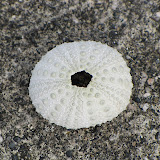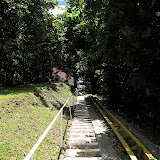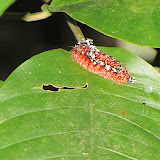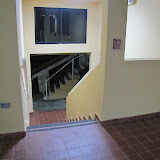31 days in Panama + 2010-11 school year tropical ecology unit
Monday, July 26, 2010
one great wild, untidy luxuriant hothouse
Saturday, July 24, 2010
Sunday, July 18, 2010
Punta Galeta
 As mentioned in the previous post, we were accompanied by Dr. Stanley Heckadon – Moreno Director of Communications and Public Programs at Punta Galeta Marine Biology Laboratory.
As mentioned in the previous post, we were accompanied by Dr. Stanley Heckadon – Moreno Director of Communications and Public Programs at Punta Galeta Marine Biology Laboratory. First Gabriel showed us the open system aquariums. They are termed open system because there is a pump that is bringing sea water directly from the ocean into each of the tanks. They each have a pipe on the opposite side that returns water to the sea. One of the drawbacks to not having a closed system (like a typical aquarium at home) is that one cannot regulate the temperature of the water. This is problematic because the water they are drawing from to bring to the tanks is in relatively shallow water that varies a good deal in temperature. Many corals cannot withstand such variability.
First Gabriel showed us the open system aquariums. They are termed open system because there is a pump that is bringing sea water directly from the ocean into each of the tanks. They each have a pipe on the opposite side that returns water to the sea. One of the drawbacks to not having a closed system (like a typical aquarium at home) is that one cannot regulate the temperature of the water. This is problematic because the water they are drawing from to bring to the tanks is in relatively shallow water that varies a good deal in temperature. Many corals cannot withstand such variability.To learn more about what Galeta has to offer, visit Galeta
Colón
Although the isthmus had been used to transport merchandise for hundreds of years, a canal was still not a consideration and a railway was just an idea. It was the California Gold Rush that fueled the construction of the railway. People hungry for gold wanted an easier way to get to California and William Apsinwall decided to make it happen.
The city grew until 1885 when it was burned down in the Colombian Civil War and then burned again in 1915. In the late 1940s Colón was established as a Free Trade Zone and flourished for the next 25 years. There were political riots in the 1960s and since then, the city has since been in a steady state of decline, first begun by the riots then accelerated by the dictatorships of Omar Torrijos and Manuel Noriega which lasted from 1968 to 1985. The withdrawal of the U.S. military has further contributed to the city’s decline. Unemployment is about 50%. Poverty rates are even higher.
Panamanians are deeply troubled and frustrated by government refusal to acknowledge or support the city. We had an interesting conversation with a man who grew up in Colón. He is noticeably angry at what he sees as the government’s unwillingness to do anything to aid the city. He said, “they just don’t care.” When asked why, he said he didn’t know but it is clear that, “the government just doesn’t care.”
Because of the pervasive poverty, crime rates have risen. We were warned various times by Panamanians, tour guides and others who know Panama, that Colón is just too dangerous for tourists. One man said he wouldn’t even go there with a bullet proof vest!
The other troubling situation is the rapid destruction of the mangrove forests. Although the city is suffering, large companies are rapidly removing the mangroves, filling in the remaining swamps and constructing enormous storage facilities (bodegas) for all of the containers coming in on ships. Imagine miles of just Sam’s Club sized buildings.Although billions of dollars are coming and going through the port and its operations, none of it is reaching the people. They companies are not contributing to the city’s infrastructure, maintenance or renewal. They are not landscaping or building sidewalks so people can walk to work. The road to the bodegas barely has two lanes and no shoulder. There are frequent traffic jams. There is no consideration for the importance of the mangroves. There are no environmental groups rallying to preserve the mangroves and no political party is taking up the issue. They insist the container storage is economic recovery enough. Truly, it’s horrifying.
Considering the crime and poverty we were not to go to Colón unless we were escorted! We were able to contact with Dr. Stanley Heckadon-Moreno, the Director of Communications and Public Programs at Punta Galeta Marine Laboratory. He takes the train from Panama City to Colón every Friday.He provided an incredible narrative on his work in Galeta, the history of the Canal and offered some insights on the state of things in Colón. We got in and out of the city safe and sound. We didn’t get into the city at all. A Smithsonian employee picked us up at the train station and took us directly to Punta Galeta. We didn’t take any photos of the little that we saw.
Tuesday, July 13, 2010
“Brad Pitt has visited the Biomuseo. What are you waiting for?”
 Although construction is far from being complete, tours are being offered every Friday. Before entering the construction site, we were given an overview of what the final product will be. Of the seven future galleries, we think the two most interesting will be “Océanos Divididos” and “Panamarama.” “Océanos Divididos” a place to compare the marine life of the Caribbean Sea and the other will showcase the marine life of the Pacific Ocean. They are constructing two floor to ceiling aquariums nearly side by side. Believe it or not, although only about 40 miles of land separate the two bodies of water, the aquatic ecosystems are quite different in each. The “Panamarama” gallery will be a display of Panama from the depths of the ocean to the cloud forest. Visitors will be transported through the exhibit virtually as a series of different species.
Although construction is far from being complete, tours are being offered every Friday. Before entering the construction site, we were given an overview of what the final product will be. Of the seven future galleries, we think the two most interesting will be “Océanos Divididos” and “Panamarama.” “Océanos Divididos” a place to compare the marine life of the Caribbean Sea and the other will showcase the marine life of the Pacific Ocean. They are constructing two floor to ceiling aquariums nearly side by side. Believe it or not, although only about 40 miles of land separate the two bodies of water, the aquatic ecosystems are quite different in each. The “Panamarama” gallery will be a display of Panama from the depths of the ocean to the cloud forest. Visitors will be transported through the exhibit virtually as a series of different species. Here are more of our photos:
 |
| Biomuseo - Frank Gehry |
Sunday, July 11, 2010
You could happen upon...
 an enormous variety of wildlife here on BCI. Some have referred to Panama as being "hyperdiverse" because flora (plants) and fauna (animals) from both North America and South America meet here on the isthmus. There are more species of birds here in Panama than in the US and Canada combined, and more species of plants just in the Canal Zone than all of Europe. For the first few days, it just looks green, and then as your eye becomes more trained and less overloaded by the newness of it all you begin to notice the incredible differences at every turn in the forest.
an enormous variety of wildlife here on BCI. Some have referred to Panama as being "hyperdiverse" because flora (plants) and fauna (animals) from both North America and South America meet here on the isthmus. There are more species of birds here in Panama than in the US and Canada combined, and more species of plants just in the Canal Zone than all of Europe. For the first few days, it just looks green, and then as your eye becomes more trained and less overloaded by the newness of it all you begin to notice the incredible differences at every turn in the forest. While working here on BCI we have planned a few paths to accomplish our goals. We started an interview project to get to know the scientists who are working and studying here. Our line of questioning has to do with what got them interested in science to begin with, what their research is about and how it fits into the big ecology picture, and how they conduct their research. Another project we are working on is to walk a particular trail that has a guide book written for it, re-photograph each of the points of interest and then work to caption each photo with a summary from the guide that is more easily digestible for teachers and students. We are hoping that will help give people an idea of the diversity here and and a little taste for what it is like to walk through the tropical rainforest here in Panama. A third vein we are exploring is along the lines of the historical, political, and cultural aspects of the country, which impacts the environment and the people's appreciation for their natural resources. The fourth aspect we are keeping busy with is visiting some other STRI sites (other than BCI) to get a handle on how they do public outreach and education. (see entry on Culebra). Dana and I hope that our work here will facilitate teaching our students back at Fratney, offering professional development to our immediate colleagues, and opens the doors to some continuing work...
While working here on BCI we have planned a few paths to accomplish our goals. We started an interview project to get to know the scientists who are working and studying here. Our line of questioning has to do with what got them interested in science to begin with, what their research is about and how it fits into the big ecology picture, and how they conduct their research. Another project we are working on is to walk a particular trail that has a guide book written for it, re-photograph each of the points of interest and then work to caption each photo with a summary from the guide that is more easily digestible for teachers and students. We are hoping that will help give people an idea of the diversity here and and a little taste for what it is like to walk through the tropical rainforest here in Panama. A third vein we are exploring is along the lines of the historical, political, and cultural aspects of the country, which impacts the environment and the people's appreciation for their natural resources. The fourth aspect we are keeping busy with is visiting some other STRI sites (other than BCI) to get a handle on how they do public outreach and education. (see entry on Culebra). Dana and I hope that our work here will facilitate teaching our students back at Fratney, offering professional development to our immediate colleagues, and opens the doors to some continuing work...So with that, living on the island offers opportunities to 'come across' some interesting things like iguanas outside of your room, rhinoceros beetles on patio outside of the lab, basilisk lizards (JC lizards) running away from us as we scramble for the camera, frogs calling to each other from the moats built around the greenhouses to keep out the ants, golden orb weaver spiders hoping to capture something tasty in their amazingly strong (and beautiful when they are not stuck to your face and arms) webs, and enormous trees that remind you of perspective. Check out more in the album below...
 |
| some big, some small |
Panama Viejo

Panamá Viejo (or Panamá la vieja) was the first Spanish settlement in Panamá. It was founded in 1519 by a Spanish conquistador named Pedro Arias de Ávila who is more commonly referred to just as Pedrarias. Before the Spanish arrived, this was a village inhabited by the cueva people. Historians seem to agree that PANAMÁ is a cueva word for abundance. What they don’t agree on is what may have been abundant- Butterflies? Flora? Fauna?

Little is known about why Pedrarias chose this site to build a city. The land was swampy and there wasn’t a good source of clean drinking water nearby. However, there is a sweeping view of the Bahía de Panamá and oysters were plentiful. It is also thought that the native cueva speaking people provided a good source of labor for the Spanish. It only took 40 years for the cueva people to be wiped out.

In 1671, an Welsh pirate named Henry Morgan burned the city to the ground before stealing any riches he could find. After this, the Spanish moved the city to what is known today as Casco Viejo. You’ll notice that there are few remains of the city. This is because much of the construction was not only stone, but wood and when the city was moved, many of the stones were moved and reused at the new city site.
Restoration of Panamá Viejo only began recently. It was left in a state of disrepair for over 200 years!
 You can see the steel structures put in place to support old walls. The bell tower of the original cathedral has been replaced with a modern structure that cannot be seen from the outside of the building.
You can see the steel structures put in place to support old walls. The bell tower of the original cathedral has been replaced with a modern structure that cannot be seen from the outside of the building.You can explore more at Panamá Viejo
and check out more pics...
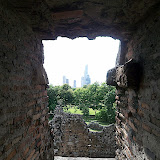 |
| Panamá Viejo |
Thursday, July 8, 2010
Punta Culebra
Take a minute to check out their website. Culebra Island has an interesting history and lots of natural wonders we found worth exploring.
Be sure to take a look at the pics!
 |
| Amador Causeway |
Amador Causeway
For many years after the Spanish arrived, the islands were a pirate’s paradise. Trade ships that were arriving to and leaving from the islands full of riches were the primary targets!
When the United States took over construction of the Panama Canal in the early 1900s, they used the rocks and earth removed from the Culebra and Guillard Cuts to connect the four islands. The causeway creates a breakwater that protects the ships waiting to enter the canal. It also helps prevent the buildup of sediment that could clog the entrance to the canal.
In 1913 all four islands were joined and became known as Fort Grant. This military zone was built to protect canal access during World War I, World War II and the Cold War. Many of the fortifications and underground bomb proof structures still exist. (We did not get to see any of them!)
In the 1970s, after the United States decided it would give the Panama Canal back to the Panamanians, a transition began. The United States started to move out and the Panamanians gradually moved in. During that time, however, access to the causeway was limited.
Finally, on December 31, 1999 the entire Canal Zone, including the Amador Causeway was returned to Panama. Since then, the causeway has begun anew. There is little, if any obvious evidence of the U.S. military base. There are new buildings and buildings under construction. Surely the Amador Causeway will continue to attract the locals and tourists alike!
Saturday, July 3, 2010
Friday, July 2, 2010
Milwaukee reports on UWM at STRI study!
Sentinel last week. We also have met Scott. He showed us around the greenhouse where he is doing some of his research. The photo shows Scott describing his current research to us in the STRI greenhouses at Gamboa.
UWM tree study
sheds light on forest diversity
Researchers draw parallels between communities and growth
By Sarah Perdue of the Journal Sentinel
Trees do not make good neighbors, at least to their own kind.
That so-called negative feedback, where young seedlings tend to die if an adult tree of the same species is nearby, is one way forests maintain diversity. Now, a group of researchers, including two scientists from the University of Wisconsin-Milwaukee, say they know how it happens.
Their results, published online Friday in the journal Nature, show that abundant tree species are less susceptible to disease inflicted by soil-borne organisms.
"People have approached this question and assumed that the major enemies are above ground, such as rodents or insects," said Scott Mangan, a post-doctoral researcher at UWM and the Smithsonian Tropical Research Institute and the lead author of the study. "Our paper suggests we have to consider what is below ground as well."
Working on Barro Colorado Island in the Panama Canal, the researchers selected six tree species found in forests there for a greenhouse experiment. They planted seedlings of each species in pots containing soil collected near adult trees of those same species - each species was planted in the six different soil types. They then measured the effects the soil had on the growth of seedlings from the various species.
"We wanted to test how seedlings perform in the presence of their own soil communities as opposed to other species' soil communities," Mangan said. "The worse a species does when grown with their own soil, the stronger the negative feedback."
Previous studies have suggested that predators of a specific tree grow in numbers as that species becomes more abundant in a forest. If that were true, the researchers would expect that seedlings of more abundant species show more negative feedback.
Instead, they found the opposite was true: More abundant species were less harmed by the soil communities. In other words, the soil communities are the cause of the diversity, not an effect.
"The species that are hit hardest by these (soil) organisms are always going to be lowest in abundance," said Stefan Schnitzer, a UWM professor of biology and co-author of the study.
The protective environment of a greenhouse does not perfectly mimic a forest, however, so the researchers needed to determine if the soil near adult trees in a forest has the same effect on seedling growth. They grew seedlings much like they had done in the greenhouse, only now they planted seeds in soil near adult trees in an established forest at Gigante Peninsula in mainland Panama, where rodents and insects could get to the seedlings.
"If it were insects driving this pattern, we'd expect leaf damage to be higher in offspring of the same species," Mangan said. Instead, they saw no pattern of leaf damage between the species, which meant the negative feedback they were seeing in the forest was also due to organisms in the soil.
Implicating soil-borne organisms in plant disease is not a new idea. Farmers, for example, rotate what they grow in a particular field from season to season to prevent crop-specific soil pests.
This study shows for the first time that the soil organisms are targeting seedlings in tropical forests in a way that helps to maintain the diversity of the forests.
"One of the great mysteries of lowland tropical rainforests is their extraordinary richness in tree species," said Stephen Hubbell, a professor of ecology and evolutionary biology at UCLA who was not involved in the research. "This is a marvelous, well-designed study that makes a major contribution to our understanding of how tropical forests work."
Mangan said the next step will be to identify the soil organisms that specifically affect each species.
"If we can identify the mechanisms and important organisms that are needed to maintain a diverse forest, that goes a long way when we are trying to, say, reforest a cleared area," he said.
http://www.jsonline.com/news/education/97208709.html
Miraflores Locks
We treated ourselves to all of the tourism attractions: a 10 minute documentary in the theater (very brief in comparison to David McCallough’s 600 page history), the exhibition hall houses a history of the construction of the canal, an ecological exhibit that highlights the canal’s watershed and some of the plants and animals found there, and a full scale pilot training simulator and route maps. But the highlight was being there in time to watch two ships go through the locks! The sun came out just in time for us to find a spot on the rooftop observation deck and take in all of the action.
Here is some canal trivia you can impress your friends with:
1. The main work on the Canal was completed in 1914. Construction of 3 new locks is underway. The expansion project will be completed in 2014.
2. The cost of building the canal was $380 million dollars. ($310 million for actual construction; $20 million for sanitation; $40 million paid to the original French companies; and $10 million paid to Panama for rights)
3. Construction employed more than 43,400 persons (at the height of activity in 1913).
4. It is estimated that 25,000 people died building the canal. That’s about 500 per mile.
5. Over 152.9 million cubic meters of land and was removed. Some of it was used to build the Amador Causeway. (More on that in future posts.) I don’t know where the rest of it went yet!
6. A ship traveling from New York to San Francisco can save 7,872 miles using the Panama Canal instead of going around the tip of South America.
7. It takes 24 hours to pass through the canal.
8. Today it costs between $200,000 and $250,000 to transit the canal. The smallest charge was 45 cent to swimmer Albert H. Oshiver, who swam through the locks in December, 1962.
9. Approximately 12,000 oceangoing vessels now pass through the Canal yearly, almost 35 a day.
10. The record of 14,807 ship transits was set in 1968.
11. Each lock in the Canal system is 1,000' long, 110' wide, and 70' deep. The new locks will be larger to accommodate even bigger ships that are now being built.
Click below to reach the album for more photos...
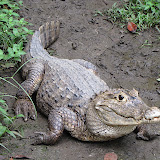 |
| Summit Zoo & Miraflores Locks |
Summit Zoo
The gardens were created by the Panama Canal Company in 1923 for the study of tropical plants. One source says that the gardens were a place to reproduce and distribute tropical plants. No matter their original purpose, the gardens are home to some 4,000 plants!
In 1985 the gardens were returned to the Panamanians. It is not clear when the zoo was added. Some of the animals have been rescued from poachers or other illegal wild life trading schemes. As far as we can tell, there is no program in place yet to rehabilitate such animals and return them to their natural habitat.
The guide books suggest that there has been steady decline in the upkeep of the gardens and zoo over the years. We were warned that the cages might be small and that we might be disturbed by some of the conditions of the animals and their enclosures.
Sarah and I were pleasantly surprised to find that for the most part, that although the cages were small, the animals seemed well cared for and that the contents of the enclosures gave the appearance of replicating the animals’ habitat. There were some sad and injured animals, but seeing the veterinary clinic assured us that someone would take care of them.
The Summit Zoo website indicates that the Botanical Gardens and Zoo are under new leadership. “The transformation of Summit Park has initiated. Our fond memories speak of a botanical garden, a zoo and a recreational park. Summit continues to be all of these and at the same time prepares to take on a new role: The conservation of Panama’s species in peril and the commitment to research and investigation of Panama’s biodiversity.”
That all said, we did get to see animals that we may never see in the wild.
Canopy Tower walk


Sunday, June 27, 2010
Friday, June 25, 2010
Science in the tropical forest!
One model he uses to study the maintenance of biodiversity is lianas. A liana is a woody vine so this
 encompasses many different species of vines. These lianas sometimes take over the trees in which they climb. In many instances their growth rises to the forest canopy and
encompasses many different species of vines. These lianas sometimes take over the trees in which they climb. In many instances their growth rises to the forest canopy andAs we walked to the central plateu where we recorded our observations we saw many interesting things along the way!


Click below to see more photos of our hike - including an ameiva lizard...
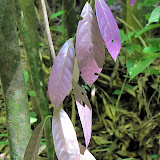 |
| 50 ha plot |
Thursday, June 24, 2010
Firsts and more firsts. . .
 It was a rainy first morning on Barro Colorado Island, but it cleared up by breakfast time. The sun was out for the rest of the day and we took a welcome walk into the jungle to get our boots wet. It was hot and humid, as you may have guessed.
It was a rainy first morning on Barro Colorado Island, but it cleared up by breakfast time. The sun was out for the rest of the day and we took a welcome walk into the jungle to get our boots wet. It was hot and humid, as you may have guessed.

 Today was our first trip into Gamboa. Gamboa was built for canal workers in the early 1900s. This house was for the Canal Director or some important person.
Today was our first trip into Gamboa. Gamboa was built for canal workers in the early 1900s. This house was for the Canal Director or some important person.We made our first trip into Panama City.
 Our first stop was at the Smithsonian Institute to get ID badges.
Our first stop was at the Smithsonian Institute to get ID badges.Our first meal in Panama City was at Stefan's favorite pizza place.

We didn't have much time in the city, but we did get our first feel for it. It seems very culturally diverse. We can't wait to get back in for some real exploring!






